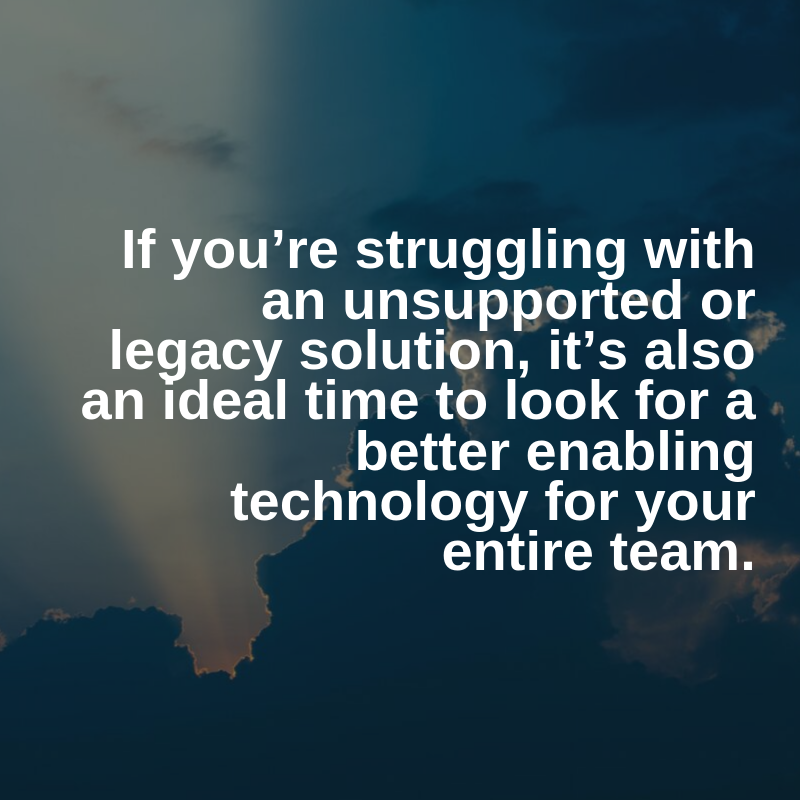Dealing with Unsupported Network Design Software? There’s a Silver Lining
 It can be incredibly frustrating when the software you use to run your supply chain will become unsupported. This is happening with many on-premise solutions. Some tools may be acquired by competitors, who then incorporate them in a vastly more expensive package. The dilemma here often is: do I take the path of least resistance and upgrade to my current vendor’s costly new package, or do I risk running my business on a legacy solution a bit longer? The latter is not really an option. Attempting to run your supply chain on unsupported software is like walking a tightrope without a net. You can’t risk system outages and downtime, which disrupt your entire workflow and erode customer trust. If you make modifications to the tool, you’re on your own. Sometimes it seems like you don’t have a real alternative, other than what your current vendor is offering. That’s what I thought when I worked for a large company in the UK.
It can be incredibly frustrating when the software you use to run your supply chain will become unsupported. This is happening with many on-premise solutions. Some tools may be acquired by competitors, who then incorporate them in a vastly more expensive package. The dilemma here often is: do I take the path of least resistance and upgrade to my current vendor’s costly new package, or do I risk running my business on a legacy solution a bit longer? The latter is not really an option. Attempting to run your supply chain on unsupported software is like walking a tightrope without a net. You can’t risk system outages and downtime, which disrupt your entire workflow and erode customer trust. If you make modifications to the tool, you’re on your own. Sometimes it seems like you don’t have a real alternative, other than what your current vendor is offering. That’s what I thought when I worked for a large company in the UK.
Attempting to run your supply chain on unsupported software is like walking a tightrope without a net. – Tweet this
We were using a product with a perpetual license and an annual maintenance contract. Every year, we would renew the maintenance contract almost instinctively. Changing wasn’t even on our radar until we were headed into a period of significant overhaul in the supply chain. Suddenly, the models we needed to support decision-making no longer fit. The maintenance contract we had covered support for bugs in the current model or issues with the software, but it didn’t cover building an entirely new model. At the same time, we knew our current software would eventually be phased out by the vendor. This posed several risks for us.
A shrinking resource pool, mounting costs and a lack of decision-making speed
The software had been around for a reasonable amount of time, so the number of people who knew how to use it was dwindling. We were dependent on the vendor’s consultants to make changes to our model. This presented an immediate challenge due to the time and cost required every time we had to engage external consultants. We asked ourselves, do we wait two months to secure budget and time from a consultant or can we get close enough to the answers we need with a few shortcuts and manipulations in Excel on the side?
Cutting corners and taking shortcuts was not ideal. We wanted to have a robust analysis that we fully understood. But the speed of analysis did not match the speed of decision-making required by the business. With a shrinking resource pool and a big supply chain redesign on the horizon, we knew if we didn’t address this, we would be in trouble.
It’s tempting to take the path of least resistance
We thought our only choice was to upgrade to the vendor’s costly new network design package. After all, our management team had already bought into this vendor. They were the market leader and we were heavily invested in their training and resources. But their sales process was not customer focused. It was the opposite: aggressive and inflexible. The new solution was way too expensive and complex, compared to the legacy product. We didn’t need all the features it offered. On top of that, we would have to sign off for three years. We decided to take a step back and evaluate our options. Luckily, we found a partner with comparable pricing but with a less complex solution that our entire team could use.
If you’re in this situation, here’s what you should consider
Switching from a known vendor to a completely new technology may seem daunting, but it’s actually a blessing in disguise. Based on this experience, I would advise teams in this situation to do the following when considering a new technology partner.
- Focus on ease of use: your technology should not be a bottleneck. It should be an enabler.
- Evaluate cost vs realizable value: is the vendor’s upgrade to your legacy tool really an upgrade or is it a migration to entirely new system? Will you use 60% of the features and upwards? Then by all means, go for it. Will you use close to 10% of the features? Then you won’t get much value from a feature-rich and costly product.
- Don’t take a standard RFI approach: Don’t talk about functionality but rather about the capabilities you need to build within your business. As supply chain professionals, we often fall into the trap of creating a functional checklist procurement can then turn into a scoring model for new vendors. Things like: how many different statistical models does the tool use, how do you enter/upload data, etc.. Instead, think in terms of capabilities. For example: “I need to enable our supply chain planners to assess the impact of forward stock locations when introducing a new portfolio. That’s the capability that I want.” Ask vendors to show you to how answer that question as a supply chain planner. This is more valuable and will allow you to find out if the vendor truly understands what you’re trying to do with our supply chain.
- Look for flexibility: Why sign a three-year commitment? In today’s business environment a lot of things can change in three years. Look for vendors who offer flexible subscriptions.
- Talk to peers and analysts: other people in your network may have experience with vendors you haven’t heard about. Ask around.
Your supply chain technology should not be a bottleneck. It should be an enabler. – Tweet this
Find a silver lining
I know change is hard, but there is a silver lining. If you’re struggling with an unsupported or legacy solution, it’s also an ideal time to look for a better enabling technology for your entire team. Involve your key stakeholders in the selection process and put together a small team with a starting problem you want to work on. Your team and your business will thank you for it.
Are you struggling with unsupported network design software for now? Curious how AIMMS compares to other solutions? Check out this page to learn more and download our Buyer’s Guide to Network Design Software for a software selection checklist.





